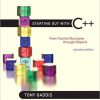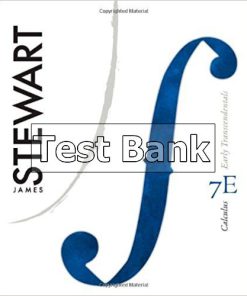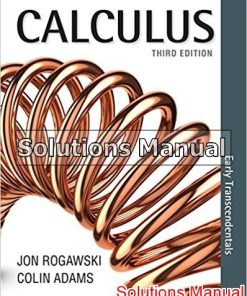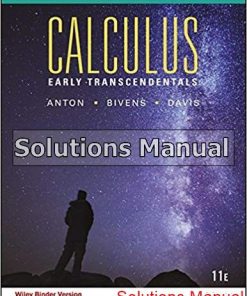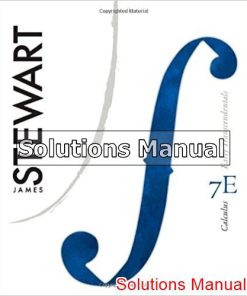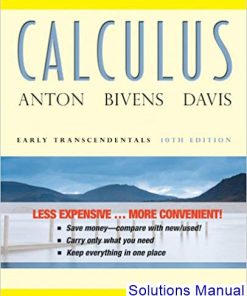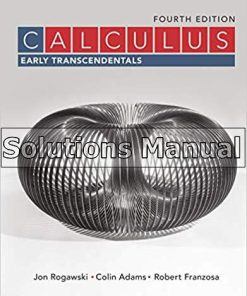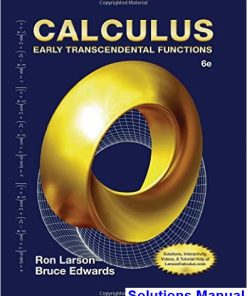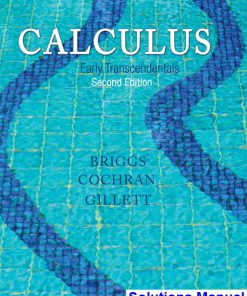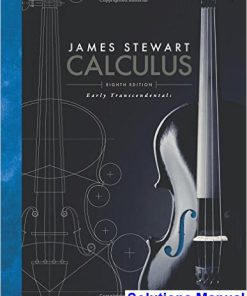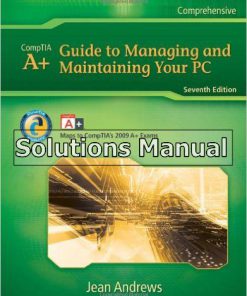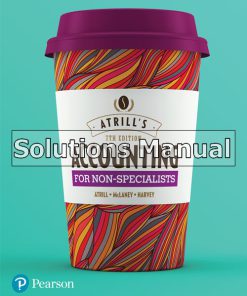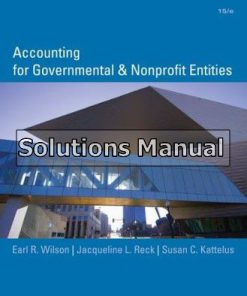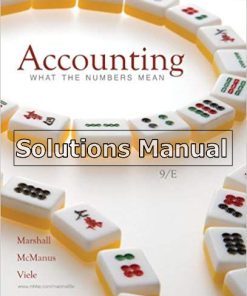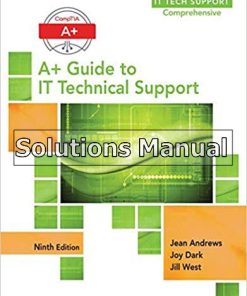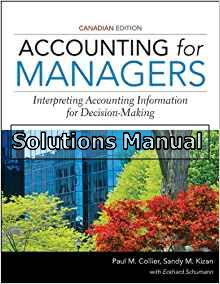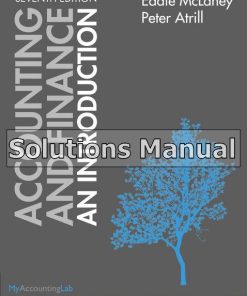Calculus Early Transcendentals 7th Edition Edwards Solutions Manual
$50.00 Original price was: $50.00.$26.50Current price is: $26.50.
Calculus Early Transcendentals 7th Edition Edwards Solutions Manual.
This is completed downloadable of Calculus Early Transcendentals 7th Edition Edwards Solutions Manual

Product Details:
- ISBN-10 : 0131569899
- ISBN-13 : 978-0131569898
- Author: C. Henry Edwards (Author), David E. Penney (Author)
This text is rigorous, fairly traditional and is appropriate for engineering and science calculus tracks. Hallmarks are accuracy, strong engineering and science applications, deep problem sets (in quantity, depth, and range), and spectacular visuals.
Table of Content:
1 Functions, Graphs, and Models
1.1 Functions and Mathematical Modeling
Investigation: Designing a Wading Pool
1.2 Graphs of Equations and Functions
1.3 Polynomials and Algebraic Functions
1.4 Transcendental Functions
1.5 Preview: What Is Calculus?
REVIEW — Understanding: Concepts and Definitions
Objectives: Methods and Techniques
2 Prelude to Calculus
2.1 Tangent Lines and Slope Predictors
Investigation: Numerical Slope Investigations
2.2 The Limit Concept
Investigation: Limits, Slopes, and Logarithms
2.3 More About Limits
Investigation: Numerical Epsilon-Delta Limits
2.4 The Concept of Continuity
REVIEW – Understanding: Concepts and Definitions
Objectives: Methods and Techniques
3 The Derivative
3.1 The Derivative and Rates of Change
3.2 Basic Differentiation Rules
3.3 The Chain Rule
3.4 Derivatives of Algebraic Functions
3.5 Maxima and Minima of Functions on Closed Intervals
Investigation: When Is Your Coffee Cup Stablest?
3.6 Applied Optimization Problems
3.7 Derivatives of Trigonometric Functions
3.8 Exponential and Logarithmic Functions
Investigation: Discovering the Number e for Yourself
3.9 Implicit Differentiation and Related Rates
Investigation: Constructing the Folium of Descartes
3.10 Successive Approximations and Newton’s Method
Investigation: How Deep Does a Floating Ball Sink?
REVIEW — Understanding: Concepts, Definitions, and Formulas
Objectives: Methods and Techniques
4 Additional Applications of the Derivative
4.1 Introduction
4.2 Increments, Differentials, and Linear Approximation
4.3 Increasing and Decreasing Functions and the Mean Value Theorem
4.4 The First Derivative Test and Applications
Investigation: Constructing a Candy Box With Lid
4.5 Simple Curve Sketching
4.6 Higher Derivatives and Concavity
4.7 Curve Sketching and Asymptotes
Investigation: Locating Special Points on Exotic Graphs
4.8 Indeterminate Forms and L’Hôpital’s Rule
4.9 More Indeterminate Forms
REVIEW – Understanding: Concepts, Definitions, and Results
Objectives: Methods and Techniques
5 The Integral
5.1 Introduction
5.2 Antiderivatives and Initial Value Problems
5.3 Elementary Area Computations
5.4 Riemann Sums and the Integral
Investigation: Calculator/Computer Riemann Sums
5.5 Evaluation of Integrals
5.6 The Fundamental Theorem of Calculus
5.7 Integration by Substitution
5.8 Areas of Plane Regions
5.9 Numerical Integration
Investigation: Trapezoidal and Simpson Approximations
REVIEW — Understanding: Concepts, Definitions, and Results
Objectives: Methods and Techniques
6 Applications of the Integral
6.1 Riemann Sum Approximations
6.2 Volumes by the Method of Cross Sections
6.3 Volumes by the Method of Cylindrical Shells
Investigation: Design Your Own Ring!
6.4 Arc Length and Surface Area of Revolution
6.5 Force and Work
6.6 Centroids of Plane Regions and Curves
6.7 The Natural Logarithm as an Integral
Investigation: Natural Functional Equations
6.8 Inverse Trigonometric Functions
6.9 Hyperbolic Functions
REVIEW – Understanding: Concepts, Definitions, and Formulas
Objectives: Methods and Techniques
7 Techniques of Integration
7.1 Introduction
7.2 Integral Tables and Simple Substitutions
7.3 Integration by Parts
7.4 Trigonometric Integrals
7.5 Rational Functions and Partial Fractions
7.6 Trigonometric Substitutions
7.7 Integrals Involving Quadratic Polynomials
7.8 Improper Integrals
SUMMARY — Integration Strategies
REVIEW – Understanding: Concepts and Techniques
Objectives: Methods and Techniques
8 Differential Equations
8.1 Simple Equations and Models
8.2 Slope Fields and Euler’s Method
Investigation: Computer-Assisted Slope Fields and Euler’s Method
8.3 Separable Equations and Applications
8.4 Linear Equations and Applications
8.5 Population Models
Investigation: Predator-Prey Equations and Your Own Game Preserve
8.6 Linear Second-Order Equations
8.7 Mechanical Vibrations
REVIEW — Understanding: Concepts, Definitions, and Methods
Objectives: Methods and Techniques
9 Polar Coordinates and Parametric Curves
9.1 Analytic Geometry and the Conic Sections
9.2 Polar Coordinates
9.3 Area Computations in Polar Coordinates
9.4 Parametric Curves
Investigation: Trochoids Galore
9.5 Integral Computations with Parametric Curves
Investigation: Moon Orbits and Race Tracks
9.6 Conic Sections and Applications
REVIEW – Understanding: Concepts, Definitions, and Formulas
Objectives: Methods and Techniques
10 Infinite Series
10.1 Introduction
10.2 Infinite Sequences
Investigation: Nested Radicals and Continued Fractions
10.3 Infinite Series and Convergence
Investigation: Numerical Summation and Geometric Series
10.4 Taylor Series and Taylor Polynomials
Investigation: Calculating Logarithms on a Deserted Island
10.5 The Integral Test
Investigation: The Number p, Once and for All
10.6 Comparison Tests for Positive-Term Series
10.7 Alternating Series and Absolute Convergence
10.8 Power Series
10.9 Power Series Computations
Investigation: Calculating Trigonometric Functions on a Deserted Island
10.10 Series Solutions of differential Equations
REVIEW — Understanding: Concepts, and Results
Objectives: Methods and Techniques
11 Vectors, Curves, and Surfaces in Space
11.1 Vectors in the Plane
11.2 Three-Dimensional Vectors
11.3 The Cross Product of Two Vectors
11.4 Lines and Planes in Space
11.5 Curves and Motion in Space
Investigation: Does a Pitched Baseball Really Curve?
11.6 Curvature and Acceleration
11.7 Cylinders and Quadric Surfaces
11.8 Cylindrical and Spherical Coordinates
REVIEW – Understanding: Concepts, Definitions, and Results
Objectives: Methods and Techniques
12 Partial Differentiation
12.1 Introduction
12.2 Functions of Several Variables
12.3 Limits and Continuity
12.4 Partial Derivatives
12.5 Multivariable Optimization Problems
12.6 Increments and Linear Approximation
12.7 The Multivariable Chain Rule
12.8 Directional Derivatives and the Gradient Vector
12.9 Lagrange Multipliers and Constrained Optimization
Investigation: Numerical Solution of Lagrange Multiplier Systems
12.10 Critical Points of Functions of Two Variables
Investigation: Critical Point Investigations
REVIEW — Understanding: Concepts, Definitions, and Results
Objectives: Methods and Techniques
13 Multiple Integrals
13.1 Double Integrals
Investigation: Midpoint Sums Approximating Double Integrals
13.2 Double Integrals over More General Regions
13.3 Area and Volume by Double Integration
13.4 Double Integrals in Polar Coordinates
13.5 Applications of Double Integrals
Investigation: Optimal Design of Race Car Wheels
13.6 Triple Integrals
Investigation: Archimedes’ Floating Paraboloid
13.7 Integration in Cylindrical and Spherical Coordinates
13.8 Surface Area
13.9 Change of Variables in Multiple Integrals
REVIEW – Understanding: Concepts, Definitions, and Results
Objectives: Methods and Techniques
Appendices
A: Real Numbers and Inequalities
B: The Coordinate Plane and Straight Lines
C: Review of Trigonometry
D: Proofs of the Limit Laws
E: The Completeness of the Real Number System
F: Existence of the Integral
G: Approximations and Riemann Sums
H: L’Hôpital’s Rule and Cauchy’s Mean Value Theorem
I: Proof of Taylor’s Formula
J: Conic Sections as Sections of a Cone
K: Proof of the Linear Approximation Theorem
L: Units of Measurement and Conversion Factors
M: Formulas from Algebra, Geometry, and Trigonometry
N: The Greek Alphabet
Answers to Odd-Numbered Problems
References for Further Study
Index
People Also Search:
calculus early transcendentals edwards
calculus early transcendentals 7th edition edwards
calculus early transcendentals 7th edition
calculus early transcendentals 7th edition download scribd
calculus early transcendentals 7th edition solution manual download pdf
Instant download after Payment is complete
You may also like…
Solutions Manual
Calculus Early Transcendentals 3rd Edition Rogawski Solutions Manual
Solutions Manual
Calculus Early Transcendentals 11th Edition Anton Solutions Manual
Solutions Manual
Calculus Early Transcendentals 7th Edition Stewart Solutions Manual
Solutions Manual
Calculus Early Transcendentals 10th Edition Anton Solutions Manual
Solutions Manual
Calculus Early Transcendentals 4th Edition Rogawski Solutions Manual
Calculus and Mathematics
Calculus Early Transcendentals 6th Edition Edwards Solutions Manual
Calculus and Mathematics
Calculus Early Transcendentals 2nd Edition Briggs Solutions Manual
Related products
Solutions Manual
Solutions Manual
Accounting for Governmental and Nonprofit Entities 15th Edition Wilson Solutions Manual
Solutions Manual
A+ Guide to IT Technical Support Hardware and Software 9th Edition Andrews Solutions Manual



